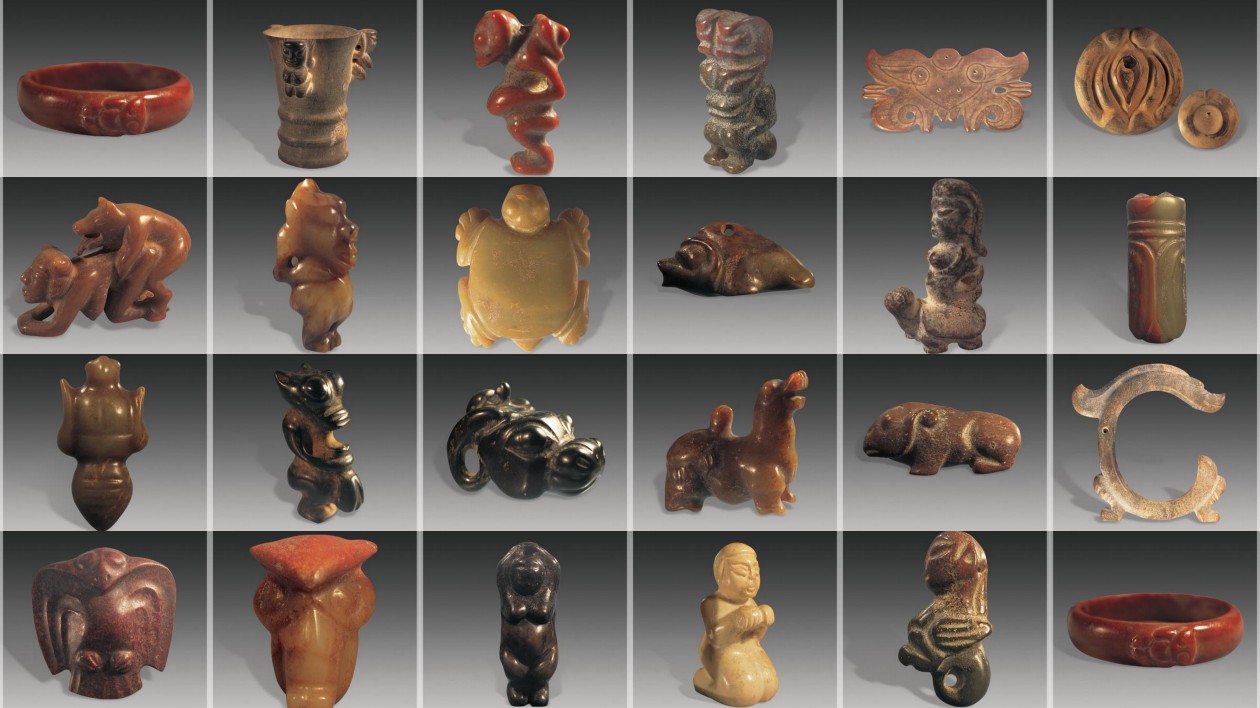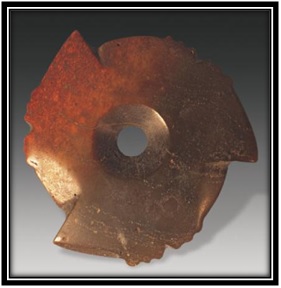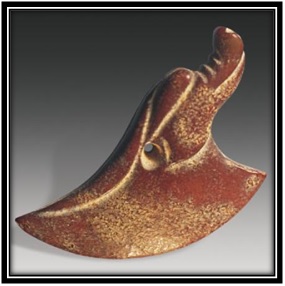Utensils and accessories – 器物与饰物 (part 2)
—
Fig 9.7
9.7. 三孔刀形佩
长5.8cm,高3.5cm,厚1.4cm。
青玉,质优,有灰皮,棕红沁色。
其造型为一梯形三孔刀,其刃部呈凸弧形,刃钝,其脊部两侧均减地,在减地部分均匀分布三个对钻斜孔;刀之纵断面呈矛头形。脊部减地的目的在于将刀背嵌牢在刀柄上,然后在三孔的位置加穿钉或绳索加固。三孔刀或七孔刀是夏、商常见的玉、石器,由此可见泛红山文化的深远影响。
9.7. Stepped Knife with three holes
Length: 5.8cm, high: 3.5cm, thickness: 1.4cm.
It is made of sapphire with corrosive reddish brown and gray markings.
The shape of the knife is flat trapezoidal like with three bifacial drilling slant holes at its upper part, and both sides of the upper edge were cut lower than the surfaces and formed a horizontal convex tenon, so called stepped knife, the three holes were evenly arranged on the tenon, the purpose of making the tenon is to insert the knife into the wooden handle tightly. This kind of jade knifes with three or seven perforations were common ritual devices in Xia and Shang Dynasty, it reflected the far-reaching impact of the Pan-Hongshan culture.
—
Fig 9.8
9.8. 蟹螯形玦
长6cm,缺口长4.5cm,最厚0.5cm。
青玉,大部分呈黄褐色沁色,表面有灰皮,蚀纹,蚀孔。
其造型为一螃蟹螯形玦。中间较厚,边缘部减薄。缺口呈 “一”字形,缺口之内端为一对钻漏斗形孔。新石器时期江浙一带的良渚文化及台湾的卑南文化均有与此类似的玉玦,所以泛红山文化是中国东南沿海一带新石器时期文化的重要源头。
- 9.8 Pincer-shaped Jue
Length: 6cm, maximum thickness: 0.5cm, the length of the slot: 4.5cm.
It is made of sapphire with corrosive brown skin and pits.
It is a flake pincer-shaped pendant named Jue (a ring with a slot). Its peripheral edge was thinned into blade like. There is a bifacial drilling funnel-shaped hole at the end of the slot. There were many similar to this kind of Jue pendants during the Neolithic period; they were mainly distributed in southeast coast of China, such as Liangzhu cultural area in Jiangsu and Zhejiang, and the Beinan cultural area in Taiwan, They derived from the Pan-Hongshan cultural jade.
—
Fig 9.9
9.9. 神人柄圭
长14.5厘米,宽4.6厘米。厚0.5厘米。
青玉,又黑斑,棕、红、黄等沁色,有灰皮蚀斑、蚀纹。
造型为一有柄的玉圭,柄形为一个头生大角的神人。圭体上方饰有四道凸弦纹。神人形为:蹲姿,面朝前,水滴状双目,“一”字形口。头顶戴高冠,头顶两侧生一双大角。双手置于膝上。圭体中间厚边缘减薄。此圭设计奇特、美观,工艺精湛。此圭一侧的蚀纹与沁色构成了一幅美妙的风景画。画中可见起伏的山峦,蜿蜒的小路,葱郁的林木等,可谓鬼斧神工,绝妙佳作。商周时期的琬圭源于此。
- 9.9 Gui with the alien shaped handle
Length: 14.5cm, width: 4.6cm, thickness: 0.5cm.
It is made of sapphire with corrosive brown, red, black, and yellow markings and pits.
This modeling is a Gui with a handle (Gui is a rectangular plaque used for ritual device). This Gui basically is rectangular but curved corners. The shape of the handle is an alien with a pair of big horns. The upper part of the Gui were decorated four relief horizontal lines, and the peripheral edge of it was chamfered. The shape of the alien is: squatting, drop-shaped eyes, facing front, closed mouth, wearing a high crown, a pair of big horns on the both sides of head, and hands on laps. The design of this Gui is fantastic, beautiful and exquisite workmanship, and the corrosive colorful surface naturally formed a wonderful landscape painting, it can be seen the rolling hills, winding paths, lush forests, etc. A kind of Gui named Wangui used in Shang and Zhou dynasties was followed this form which has curved corners.
—
Fig 9.10
- 9.10 云纹冠
通高13.4cm,底部呈椭圆形,长轴6.2cm,短轴5.5cm。顶部斜切口椭圆长轴9cm,短轴8cm。灰绿玉,有灰皮,蚀斑,蚀孔。玉声清脆。
其造型为一椭圆简形玉冠,顶端为一斜口,前低,后高,呈倒置马蹄形,故称马蹄形玉冠。筒壁很薄,不足2mm。筒壁外侧饰浅浮雕宽边卷云纹。下端边沿两侧各有一锥形孔。上边沿后面内侧有三道纵向凹槽。
此玉冠用法是将头发编好后,从玉冠的下端穿入,斜口朝前,直立于头顶,然后将头发从斜口上端披向脑后,再用一簪穿过下边沿两侧之小孔以固定。
- 9.10 Crown with moire decorations
High 13.4cm, the bottom is in oval-shape, the long axis is 6.2cm; the short axis is 5.5cm. The top is an oblique incision in ellipse shape, its long axis is 9cm and the short axis is 8cm.
It is made of celadon with corrosive gray skin and crisp percussion.
It is tubular-shaped crown with an oval-shaped oblique incision on the top. The front of it is lower, and the back of it is higher, the overall shape is an inverted horseshoe like. The cylinder wall is thin, less than 2mm. Outside of the cylinder wall was decorated with bas-relief wide moires. There two slant holes on each side of the cylinder near the bottom, and three vertical grooves on the inside back wall.
The way to use the crown is that: braided the hair then penetrated it from the bottom to the top of the tube, to put the crown upright on the head, and the oblique incision face forward, and then hang on the hair to the back over the top of back wall of the tube, at last to use a hairpin penetrating the two holes on the lower of the tube to secure.
—
Fig 11
- 9.11 人面纹玉枕
长 24cm,高 9.5cm,宽 9.7cm。
青玉,有灰皮及蚀斑。
玉枕呈船形,两侧各饰一人面形纹饰,其形为双目上挑蚕形眉,蒜头鼻,大口微张。人面两侧饰弦纹,皆以浅浮雕及打窪技法饰出,中空,四壁厚薄均匀。此人面纹玉枕在泛红山文化玉器中具有典型性。
- 9.11 Pillow decorated with human face
Length: 24cm, high: 9.5cm, width: 9.7cm.
It is made of sapphire with corrosive gray skin and pits.
It is a boat-shaped pillow decorated with the same human face on each side. It was hollowed inside, and uniform thickness walls. The shape of the human face is: drop-shaped eyes sloping upward, silkworm-shaped eyebrow, garlic-shaped nose, and big mouth slightly open. There are three curved groove patterns on each side of the human face. The relief and depression techniques were used to the surface decorations. This is a typical jade pillow of the Pan-Hongshan culture.
—
Fig 9.12
- 9.12 琮
高16cm,上口径9cm,下口径7.7cm,中部方柱形琮体边长9cm。
黄绿玉,带有黑色斑纹,表面侵蚀较重。有棕色沁色及大面积的蚀斑和蚀孔。放大镜下可见蚀孔中有可溶性盐类所析出的透明及半透明晶体。
此琮造型与良渚文化玉琮基本相同,即外方,内圆,下端较细,上端较粗。其差别首先是方柱形琮体与上、下圆形沿口部分的比例不同。此琮上、下沿均呈圆筒形,高均为5cm,方柱形琮体高6cm。而良渚文化玉琮圆形沿口部分高度很小,其次是表面纹饰及加工方法不同。良渚文化玉琮常在方柱形琮体部分饰以精雕细刻的纹饰,而此琮在上、下圆形沿口部分及方柱形琮体部分的外表面均以打洼及磨制方法构成瓦沟状弦纹,且上、下沿口外迤,表面通体光滑无线刻纹饰,内壁也磨制光滑无棱坎。
—
- 9.12 Cong
High: 16cm, the upper caliber: 9cm, the lower caliber: 7.7cm, the cross-section of its body is square-shaped, and the edge length of the square is 9cm.
It is made of topaz with corrosive brown markings, surface erosion is heavy, and large area of corrosive plaques and pits.
Its shape is essentially the same as the Liangzhu cultural jade Cong articles; that is: square body, round hole, the body is tapered, the lower caliber smaller and the upper caliber bigger. The first difference is the proportion of the heights of the square column Cong body to the upper and lower cylindrical mouths; it is a larger proportion of the upper and lower cylindrical height, and the smaller proportion of the square column Cong body height, and the Liangzhu cultural Congs were opposite with it. Followed by is the different of the ornamentation and the different processing methods. The Liangzhu cultural Congs often were decorated density fine carved decorations on the square column Cong body, while the Pan-Hongshan cultural Cong often is plain or only the grooves or relief patterns decorated on the body. This Cong was decorated with groove patterns on the upper and lower cylinders, and the relief round ridge patterns on the square column body, and the inside wall was polished smooth. The depressing, grinding and polishing methods were used in the processing.
—












